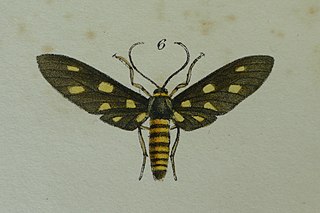
The nine-spotted moth or yellow belted burnet is a moth in the family Erebidae. The species was first described by Carl Linnaeus in his 1758 10th edition of Systema Naturae.

Amata is a genus of tiger moths in the family Erebidae. The genus was erected by Johan Christian Fabricius in 1807.

Cyanopepla is a genus of moths in the subfamily Arctiinae. The genus was erected by James Brackenridge Clemens in 1861.

Amata huebneri, the wasp moth, is a moth in the genus Amata of the family Erebidae. The species was first described by Jean Baptiste Boisduval in 1829. It is found from the Indo Australian tropics to northern Australia.
Amata humeralis is a species of moth of the family Erebidae first described by Arthur Gardiner Butler in 1876. It is found in Australia, where it has been recorded from Western Australia, the Northern Territory, Queensland and New South Wales.
Amata insularis is a species of moth of the family Erebidae first described by Arthur Gardiner Butler in 1876. It is found in Queensland, Australia.
Amata melitospila is a species of moth of the family Erebidae first described by Alfred Jefferis Turner in 1905. It is found in Australia, where it has been recorded from Queensland.
Amata nigriceps is a species of moth of the family Erebidae first described by Arthur Gardiner Butler in 1876. It is found in Australia, where it has been recorded from Queensland and New South Wales.
Amata paraula is a species of moth of the family Erebidae first described by Edward Meyrick in 1886. It is found in Australia, where it has been recorded from the Northern Territory and Queensland.
Amata xanthosoma, the yellow tiger moth, is a species of moth of the family Erebidae first described by Alfred Jefferis Turner in 1898. It is found in the northern part of the Austraian state of Western Australia.
Amata xanthura, the southern spotted tiger moth, is a species of moth of the family Erebidae. It was first described by Alfred Jefferis Turner in 1905. It is found in Australia, where it has been recorded from the Northern Territory, New South Wales and Victoria.
Amata annulata is a species of moth of the subfamily Arctiinae first described by Johan Christian Fabricius in 1775. It is found in Australia, New Guinea and the Philippines.
Amata aperta is a species of moth of the family Erebidae first described by Francis Walker in 1865. It is found in Australia and New Guinea.
Amata bicolor is a species of moth of the subfamily Arctiinae first described by Francis Walker in 1854. It is found in Queensland, Australia.

Amata wallacei is a species of moth in the family Erebidae first described by Frederic Moore in 1859. It is found on Java, Sumatra, Peninsular Malaysia and Borneo.
Amata francisca is a moth of the family Erebidae. It was described by Arthur Gardiner Butler in 1876. It is found in the Republic of the Congo, Mozambique and Sierra Leone.
Amata johanna is a moth of the family Erebidae. It was described by Arthur Gardiner Butler in 1876. It is found in Nigeria and South Africa.
Amata marina is a moth of the family Erebidae. It was described by Arthur Gardiner Butler in 1876. It is found in Cameroon, the Republic of the Congo, the Democratic Republic of the Congo, Equatorial Guinea, Gabon, Ghana, Sierra Leone, Uganda, Zambia and Zimbabwe.
Amata tomasina is a moth of the family Erebidae. It was described by Arthur Gardiner Butler in 1876. It is found in Cameroon, the Democratic Republic of the Congo, Equatorial Guinea, Ethiopia, Ivory Coast, Rwanda, Sierra Leone, Sudan, Gambia and Uganda.




